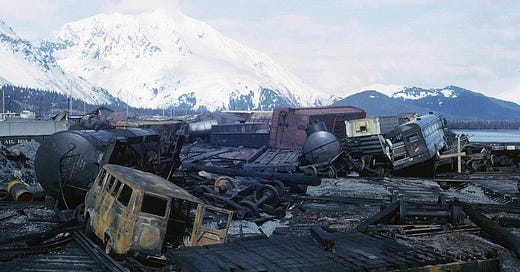We know Good Friday as a holy day for many devout Christians. It is a somber day for the multitudes that remember Jesus’ suffering on the cross; a day to mourn and meditate Christ’s death. (what-is-Good-Friday) Even though I am of the ‘spiritual not religious’ persuasion, I am aware of the significance of Good Friday.
However, Good Friday always brings my thoughts to the Good Friday earthquake that shook Alaska on March 27, 1964. When I went to Alaska in 1977, the Good Friday earthquake was still very much a topic of conversation - and fresh in the memories of some of the ‘old timers’ who’d experienced it. It is commemorated every year; this year being no exception. https://gov.alaska.gov/great-alaska-good-friday-earthquake-remembrance-day-8/ From the first year I was there onward, Good Friday and Easter came to connotate the devastation and death the 9.2 earthquake dealt to southcentral Alaska. I think perhaps it still must, given my topic. It was, and still is, the second highest magnitude earthquake recorded; the highest occurring in Chile in 1960 at 9.5 on the Richter scale.

The quake resulted in 139 deaths, many of them due to subsequent tsunamis. Waterfronts were wiped out and harbors redesigned, oil storage tanks burst into flames, downtown Anchorage streets plummeted below ground level, railroad tracks dismantled, roads rearranged and personal loss abounded. For a telling photo essay see https://www.theatlantic.com and for a more detailed historical account of the natural disaster visit The Great Alaska Earthquake & Tsunami.
The affects weren’t just limited to Alaska; areas all down the west coast suffered the consequences of massive tidal waves. The tsunamis caused damage as far away as Hawaii and Japan. There were thousands of powerful aftershocks lasting three weeks. When walking along the waterfront in Seward, I would find remnants of the railroad in the rocks along the beach. Boats turned lopsided, stranded inland offered reminders; locals kept the memories alive entrenching the fear and force in all us cheechako’s imaginations. From the minute I got off the ferry at the terminal dock in Seward, I heard the stories of how the earthquake had wiped out the old dock, of how it had been relocated to it’s present location. Thirteen years later, locals still considered it a new dock! That’s how lasting the memories of that day lodged in the hearts and minds of Alaskans. Sixty-one years later, it is being remembered and honored. While Good Friday is on April 18th this year, not on March 27th, this is what I think of on Good Friday.
While the earthquake extolled a tremendous price on the people, the infrastructure and the land of Alaska, it brought redemption in the form of better science and warning systems that save lives. Earthquake preparedness is still practiced in schools, just like fire drills. When our kids were in the elementary school in Homer, that drill consisted of filing out of the building and walking several blocks to the High School located on higher ground.
A nod of my head, a tip of my hat, a hand to my heart, I remember all that was lost on that Good Friday in 1964.
And so it is, I head into this Easter weekend with baskets to fill, eggs to hide and food to prepare. I wish you all a Happy Easter! May you find peace and joy.
Remain Curious. Be Kind. As Always With Love.
As a follow up to last week’s reference to ICE OUT, the official ICE OUT on Lake Winnipesaukee was declared Wednesday, April 16th, around 7am. Spring may finally be on it’s way here in the Lakes Region!




The ring of fire extends all the way through Central America as well! Always a chance for disaster, but beautiful country. Very interesting post and I enjoyed reading the links also.
The Ring of Fire is always in the back of people’s minds. Earthquakes, volcanoes, tsunamis! Wild, beautiful country! Happy Easter!